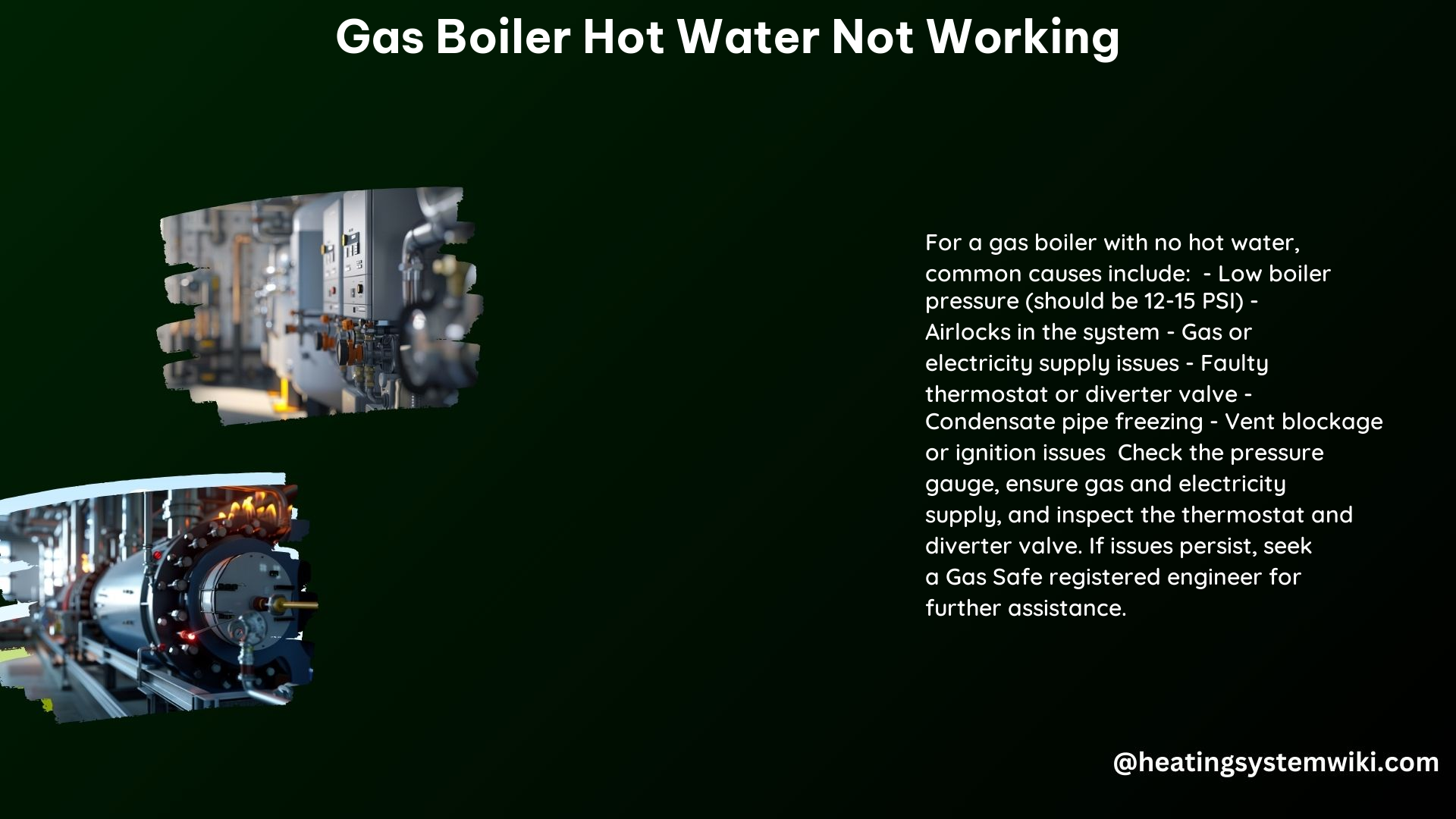If your gas boiler is not producing hot water, it can be a frustrating and concerning issue. However, with the right troubleshooting steps and a bit of technical know-how, you can often resolve the problem without the need for a professional service call. In this comprehensive guide, we’ll dive deep into the common causes of gas boiler hot water not working and provide you with a step-by-step playbook to get your system back up and running.
Diagnosing Low Water Pressure
One of the most common reasons for a gas boiler not producing hot water is low water pressure. The recommended boiler pressure range is typically between 1 and 2 bar. To check the pressure, locate the pressure gauge on your boiler. If the reading is below 1 bar or above 2 bar, you’ll need to adjust the pressure accordingly.
To increase the pressure, locate the filling loop or filling valve, which is usually a small tap or valve near the boiler. Slowly open this valve to allow more water into the system until the pressure gauge reads between 1 and 2 bar. If the pressure continues to drop, there may be a leak in the system that needs to be addressed by a professional.
Addressing Airlocks

Airlocks, or trapped air in the system, can also prevent your gas boiler from heating water effectively. To release any trapped air, you’ll need to bleed the radiators. Start by identifying the bleed valves, which are usually located at the top of each radiator. Use a radiator key or a flat-head screwdriver to slowly open the bleed valve, allowing any trapped air to escape. Once the water starts to flow, close the valve.
If the issue persists after bleeding the radiators, there may be a more significant airlock in the system that requires the attention of a Gas Safe registered engineer. They can use specialized equipment to identify and remove the airlock, restoring proper water flow to the boiler.
Checking Gas and Electricity Supply
Before delving deeper into the boiler’s internal components, it’s essential to ensure that the gas and electricity supply to the boiler are functioning correctly. If other gas-powered appliances in your home are not working, or if you notice flickering lights or other electrical issues, there may be a problem with the supply.
Start by checking the gas and electricity meters to ensure they are not indicating any issues. If the supply appears to be stable, you can move on to the next step in the troubleshooting process.
Adjusting the Thermostat
The thermostat plays a crucial role in the operation of your gas boiler. If the thermostat is not set correctly or is malfunctioning, it can prevent the boiler from heating the water. Locate the thermostat, which is often mounted on the wall, and ensure that it is set to a temperature high enough to trigger the boiler to produce hot water.
If the thermostat appears to be functioning correctly, you can try manually overriding it by adjusting the temperature setting. If the boiler then starts producing hot water, the issue may be with the thermostat itself, and it may need to be replaced.
Troubleshooting Motorized Valves
Some gas boiler systems use motorized valves to control the flow of hot water. If these valves are not working correctly, it can prevent the boiler from heating the water effectively. To check the motorized valve, locate it and try manually operating it by pulling the lever or switch. If the valve opens and allows hot water to flow, the issue may be with the valve’s motor or control system, which will require the attention of a professional.
Inspecting the Flow Pipe
In older gas boiler systems, the flow pipe that carries hot water from the boiler to the rest of the system can become clogged or empty, preventing proper water flow. Locate the flow pipe and visually inspect it for any signs of blockages or dryness. If the pipe is dry, you may need to refill the system to ensure the boiler has a sufficient water supply.
Checking the Boiler Pressure Gauge
The boiler pressure gauge is another critical component to monitor when troubleshooting a gas boiler that’s not producing hot water. If the pressure gauge reads 0, it may indicate a problem with the system that requires professional attention.
Ensure that the boiler pressure is within the recommended range of 1 to 2 bar. If the pressure is outside of this range, you may need to adjust it using the filling loop or valve, as mentioned earlier.
Technical Specifications
To ensure your gas boiler is operating within the recommended parameters, it’s essential to be aware of the following technical specifications:
- Boiler pressure: 1-2 bar (recommended range)
- Water pressure: 12-15 psi (recommended range for some systems)
Maintaining these pressure levels is crucial for the proper functioning of your gas boiler and the delivery of hot water to your home.
Conclusion
By following the comprehensive troubleshooting steps outlined in this guide, you should be able to identify and resolve the issue with your gas boiler not producing hot water. Remember to always prioritize safety and, if you’re unsure or uncomfortable with any of the steps, it’s best to seek the assistance of a Gas Safe registered engineer.
References
- Boiler Central. (n.d.). No Hot Water: Common Causes & How To Fix It. Retrieved from https://www.boilercentral.com/troubleshooting/no-hot-water-coming-from-your-boiler/
- Dereton33. (2013, November 7). No hot water from your boiler? What to look for and how to fix it. YouTube. Retrieved from https://www.youtube.com/watch?v=PhXKd10wZAM
- Reddit. (2023, October 9). Hot water boiler furnace system not working suddenly. Retrieved from https://www.reddit.com/r/hvacadvice/comments/17445uo/hot_water_boiler_furnace_system_not_working/
